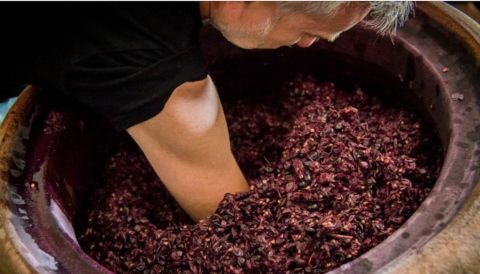From €28.50, 408 Norwegian kroner, $42.99, HK$435, £45
Loire Cabernet Franc comes in many guises and is often associated with appellations such as Chinon, Saumur-Champigny and St-Nicolas de Bourgueil but this wine, one of the most vibrant and expressive Cabernet Francs I have come across, is from further west, in the Muscadet region more well known for its white wines, which is why it is labelled Vin de France.
When I tasted the Mephisto 2018 in London last month, poured by winemaker Fred Niger at a tasting of the Biodyvin association of more than 200, mainly French, biodynamic winegrowers, he told me that the vines are, unusually, planted on granite. His wife, Claire, says this gives wines that are ‘balanced and glamorous’, capable of long ageing. This 2018 seemed remarkably youthful, especially since it was made with no added sulphur dioxide, which is typically used in winemaking as a preservative and to protect the wine from spoilage by oxygen or unwelcome microbes. It is delicious now but I reckon you could tuck it away for a good 5–10 years.
The wine’s aroma creates a light mineral impression of stone dust entwined with invitingly fresh, leafy dark-red fruit, recognisably Cabernet Franc in its pure fruit flavours yet with its own distinctive character that is as much to do with extremely fine tannins, which feel almost chalky and add to the freshness and energy, as with the flavour, though you can’t really separate flavour and texture here. The alcohol is just 12.5%.
The grapes are harvested by hand, destemmed and treated very gently in the winery – moved around by gravity rather than pumps. The wine is fermented in stainless-steel tanks over a period of 12 days with ambient yeasts. Extraction is equally gentle, just keeping the cap wet, and then the wine is aged for 15–18 months in amphorae. As the Nigers say on their website, it was tasting wines by producers such as Gravner, Cos, Vodopivec and Foradori that inspired this path but it was Philippe Viret in the southern Rhône who helped them the most. They now have around 100 amphorae, mostly French or Italian, ranging in size from 160 to 1,450 litres.
Coincidentally it was at the Amphora Day in Portugal in 2021 that I first met Claire Niger and tasted Céleste, a wonderful white wine she had made entirely in amphorae. Fred, who is in charge of winemaking apart from the two wines specifically signed by Claire, officially took over the 24-hectare (59-acre) Domaine de l’Écu in Muscadet, south-west of Nantes, from fifth-generation winegrower Guy Bossard in 2011, though he had been working alongside Bossard since 2009. The estate has been certified organic for almost 40 years and biodynamic since 1998 (by Demeter, also by Biodyvin since 2014). The Nigers are totally committed to the principles and practices of biodynamic viticulture, as they describe in great detail (in French) on their website. Nearly 80% of the vineyard is planted with white varieties (primarily Melon de Bourgogne but also Folle Blanche, Chardonnay and Chenin Blanc). The rest comprises Cabernet Franc, Cabernet Sauvignon and Pinot Noir.
Fred Niger explains why he loves to vinify wine in amphora even though it requires a lot of work, constant attention and delicate handling: ‘The natural origin of clay and the neutrality of terracotta respect the purity of the fruit and the expression of the terroir. The thermal regulation and the natural circulation of the lees favour the complexity of the wines.’ Using amphorae ‘remains for me the culmination of a global approach linked to biodynamics’ allowing him to make most of his wines without the addition of sulphur dioxide.
I am not against the careful, moderate use of sulphites. However, I admire the approach at Domaine de l’Écu. The Nigers may be referred to as non-interventionist, natural winemakers but to me they demonstrate the very best of non-interventionism: pure, complex and fresh wines that reflect the vineyard site. They taste great in their youth but also age well, and – looking at how widely the wines are distributed – travel well.
Why is it called Mephisto? Simple, Claire explains. ‘Fred is very fond of Gounod’s opera Faust and Mephisto is one of the main characters.’
This wine is made in relatively small volumes (5,000 bottles and 100 magnums) but is quite widely distributed in Europe and the US. It has sold so well in the UK, for example at the Studio Frantzén restaurant in Harrods, that it is now available only from Domaine de l’Écu’s importers Newcomer Wines, from their shop in Dalston, East London, or online. US importers are Polaner Selections in New York and Floraison Selections in California (email info@floraisonselections.com for availability there).
For our most recent coverage of amphora wines, see Amphora Day – the drama of clay, and for much, much more on the wines of the Loire, see all our articles tagged Loire.















